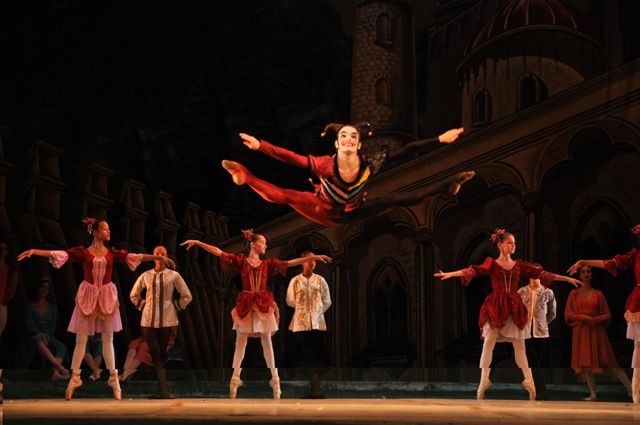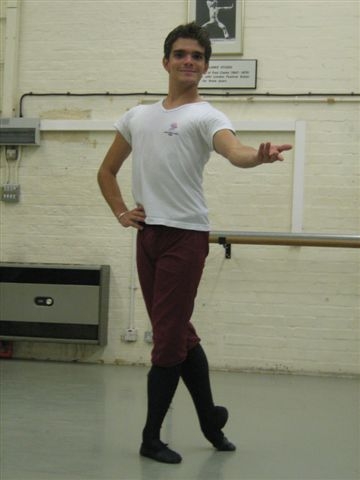Cuba’s Luis Javier Fuentes: He’s Small, but he Grows on Stage
An interview with Luis Javier Fuentes, a young dancer with the Ballet Laura Alonso (an entity of the Centro Prodanza de Cuba).
By Helson Hernandez

HT: You graduated from the National Ballet School, and since then you’ve been a member of the Centro Prodanza de Cuba, directed by Laura Alonso. When you look back and remember the school, and then you look at all the roles you’ve now performed as a professional, what conclusions do you come to, keeping in mind there’s still much ahead in your career?
Luis Javier Fuentes: I can say that these roles are nothing more than an award for the effort made throughout the entire time of study and dedication to classical ballet. Those roles have given me the satisfaction of proving to myself that you can always make it to where you want if you are compelled by willpower and love. When I look back and recall how I began in elementary school as a little child who barely knew what it really meant to be a dancer, this is when I realize that I’m realizing a dream. You see yourself standing there just before beginning a great classic like Swan Lake and then you feel that your effort wasn’t in vain. Everything is summed up in that instant after having achieved a leading role…
HT: Sacrifice a word that’s commonly bandied around when we speak about classical ballet. Based on your personal experience, do you agree with that as a description of what’s almost always attributed to your profession?
LJF: I’m so in agreement that I think the word sacrifice must have been invented by dancers. It’s something that is taken for granted in this profession and is part of the discipline of all those who love this art form. Dancers from when they’re very young have to put aside things that normal children do daily. Sacrifice is the word that accompanies you throughout all your career and your family will have to make sacrifices as well because they’ll be present at your side in any function or presentation so as not to miss even a minute of your artistic development.

Poetically, sacrifice becomes love over time. For example, when you’re going to dance and your family tells you that everyone is going to the beach on the weekend but you know you can’t because you have to practice, then you’ve reached a level of responsibility toward what you’re doing. I can’t conceive of a good dancer who doesn’t make sacrifices, because in classical ballet, like in all the arts, it’s always necessary to completely devote oneself to their art form in order to achieve the most incredible and challenging desires.
HT: We know that you’re the son of a teacher at the National School of Ballet. How difficult was it for your mother to be so close to you during your educational process, looking at you as a student and at the same time as a son? However, I suppose that there were benefits in having a member of your family so knowledgeable of your specialty.
LJF: My mother is the most important person in my life, and I believe that she’ll always be. She’s the light that’s always at the end of the tunnel, even when the darkness seems it won’t allow anything else. She’s always there. She’s the one who supports me during those moments that perhaps no other parent could.
She’s hard on me and tells me things like they are. She tests me as if I were just another one of her students. I sometimes don’t even call her mom at school because she’s one of the most rigorous teachers, so I call her “profe” (teacher). It’s a responsibility to be the son of a great teacher. She has broad knowledge of Cuban and international techniques and she shares this with me down to the most minimum details. If I’m where I am it’s because her hands have always been there when I needed them and she has pushed me forward like the wind propelling a ship.
HT: Was Ana Julia therefore an influence on you as her son in deciding to pursue ballet or was it your decision and not in her plans?
LJF: I believe that she was an influence along with many other factors. When I was only four or five I would spend hours watching the classes of male ballet, or if not I would be walking from room to room of the Garcia Lorca theatre, the former center of the National School of Ballet. All this influenced me. I grew up learning to have immense respect for classical ballet.
I have to say that she never told me that I had to be a dancer. I took judo when I was very young, and when I was eight my father was very close to Nirio Ribero, the Cuban motorcycle racing champion, and they taught me go-karting, which today has a fabulous school here in Cuba. That’s how I was when I was little. When I sat down to watch the ballet Coppelia for the first time, it was perhaps at that moment that I knew — even at such a young age — that I didn’t want to do anything else in life but dance.
HT: Have you ever experienced prejudice as a short dancer?
LJF: To say that I haven’t felt the impact of serious prejudice would be telling a lie. My last year at school was very difficult because I knew that I was small and that I had a 99 percent probability of not getting into the National Ballet of Cuba, given the height standards they demand. I believe it is a very strong and harrowing form of prejudice because it puts aesthetic qualities above artistic technique and talent. There are large companies all over the world that have shorter dancers. I’m not criticizing it here, because I think each company should follow its own interests to be successful in its particular development, but what I’ll always defend is talent.

Short dancers are necessary because we’re dynamic and there are roles that we can perform very well, like jesters and others. If you have a big heart and you demonstrate that to the public then they don’t look at your height, they simply see an artist who gives all they have to reach their highest level.
HT: So tell us then, what have been your most important roles, because your height hasn’t been an impediment for being able to dance in any of the major ballet productions and at such a young age?
LJF: There have already been many leading roles that I’ve been able to interpret, beginning with the Franz in “Coppelia.” Another one I enjoy is Basilio, in “Don Quijote,” which has a great deal to do with my character and with the Spanish roots that all of us Cubans have. Also, there was the jester in “Swan Lake,” and the character that I never dreamed of doing, which was Prince Siegfried, also in “Swan Lake.” This latter one required that I put in a lot of work to project myself with a certain dynamic, but it taught me to dance with a different elegance, more calmly, it taught me to move with another cadence. And another character I owe a great deal to — because it pushed me to a limit of performance that was previously unknown to me — was Reinfield, in “Dracula.”
HT: You’ve been able to dance on the international stages. You recently went to Brazil, in addition to having been in other countries… I imagine it has been enriching to travel and dance in other countries in fact, you’re better known and presented there than in your own country of origin.
LJF: To visit all those countries — including England, Brazil, the Dominican Republic, Mexico and Italy — allowed me to participate with prestigious companies such as the National Ballet of England.
Through its dancers I appreciated the different forms of moving my arms, their almost perfect battements, and at the same time I taught them my spins and my stregth in dancing, a characteristic of Cubans. I’ve been in performances in which we all breathed and spoke the same language: that of the family of the international ballet. It doesn’t matter where you’re from because though the styles might be different, the language is the same. Classical ballet is the same for everyone.
HT: You are always talked about as a dancer with overflowing energy. In fact, among dancers it’s said that Luis is electric on stage. I think this is also related to your restless personality. Has this ever caused you problems, occasionally not being able to control the contagious dynamic that you possess, which to a certain degree marks your dancing with agility and energy?
LJF: Well as you can imagine there are days when many of my comrades say that I’m operating at full voltage. Yes, I’m a dynamic dancer but I believe that on occasion this has helped me a lot because otherwise I wouldn’t have been successful in the role of the jester for example.

It’s also gotten me through tense moments when something went wrong; this is because I can react extremely fast. If I didn’t feel this level of “electricity,” as we say in dance jargon, then that day you can be sure that I won’t dance like I should. It’s a virtue that I never hope to lose. My dynamic when I dance is perhaps the form of expressing how much I like being on stage.
HT: What are the most latent concerns of a young artist like Luis Javier?
LJF: I have many concerns, and they’re always making me shift gears. I want to do a lot of things. I want to dance in more roles, to play more characters that push me beyond the parameters of performance that I don’t even know. I want to teach children, especially young boys; that’s something I would like to do because I believe that in them is the future of Cuban ballet that has been characterized over the last few years in producing very talented men. On the other hand, contemporary dance is something that I’ve not yet been able to do, so I would like to explore it.
HT: And with Prodanza, what plans do you have for it in the near future?
LJF: With Prodanza I plan to continue dancing all I can and to be wherever they need me. My greatest desire is to go on an international tour with the whole company, with everyone together, demonstrating that Prodanza can shine beyond our borders. Let’s hope this dream is realized soon because it would be something unforgettable.





